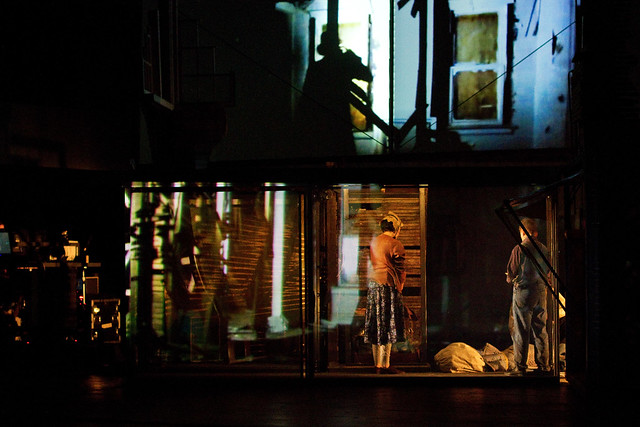For someone like myself, who is not familiar with American history at all, the show House Divided at BAM was merely too confusing. It required too much background information. Even with a little research beforehand, I could not keep on track until a friend of mine kindly whispered reasons into my ears—then I only figured out the most basic part—it was a story showing two time periods, the Great Depression and the Housing Market Crash.
For some reason, before I went to the show, my mind was set on this lie that the whole story took place during the Housing Market Crash only. Thus, during the whole show, I was wondering why people were dressed up as if they were in the Great Depression, so take my advice for this: either do as much research as one can, or don’t do it at all; half way in between can only cause one pain.
Even without my mistake on my own account, however, the House Divided was complicated. Switching between two time periods was a risk that could either ruin the performance or shine a spotlight on it—for me, the experience was somewhat negative. The attempt was understandable. The stage was literarily divided into two in the beginning, one presenting the Stock Exchange and the other setting in John Steinbeck’s novel Grapes of Wrath. Nevertheless, as the story went on, the division became obscure. Sometimes the whole stage was entirely one scene, but within a blink of an eye, it changed to another with the previous scene unfinished. Although the overall storyline was clear, if the audience hadn’t read the novel, it would be hard for them to track the details in both stories—which could only result in confusion in the end.

http://farm8.staticflickr.com/7277/7024467805_f2e1b5a288_z.jpg
It was still worthy. Even with the complication of merging stories, the production itself deserved a pet on the shoulder. The performance still had some highlights to it, and this is from someone who struggled through the entire play. Although puzzling, the visual contrast between the two brought a completely new experience to the audience. The busy transitions, including the lighting, projection and music, allowed people to dissolve into either mood quickly to my surprise (maybe that was the weird part for me, since my mood was transferred but my brain was still processing the previous information). Moreover, the idea of adding projection was fascinating. Within such a tiny stage, the projection enabled a faster and more effective transition of setting, at the same time added a modern taste to the whole production. Only if they could think about the angle of the projection, bacause from where I was sitting, the stage looked broken from the middle sometimes.
Speaking of modern taste, the addition of angled cameras was innovative. House Divided was the first theater play ever I saw that used cameras on stage, and I can be certain that it is not the last time. Since the stage was so tight, it was almost impossible for the actors to face the crowd all at once, but the camera helped them to do so. Also, since there were several scenes involved telephoning, without the cameras, it would have been two people talking to each other across the stage. However, with this technology installed, a much more realistic act became available.

http://images.nymag.com/guides/fallpreview/2012/theater120830_anticipating_560.jpg
I have to say, House Divided was a difficult play. Although the necessary details were basic for most people, without which the play could be somehow troubling to understand. However, even solely for the digital effects, the play is worthy to see, not to say the educational value of the production surpassed its challenging plots. By the end of the show, even if one were struggling like me, it won’t be hard for one to realize the impact of this performance within—just like what it felt like for people during the Great Depression and the Housing Market Crash—a feeling of concern, uncertainty and anger.

